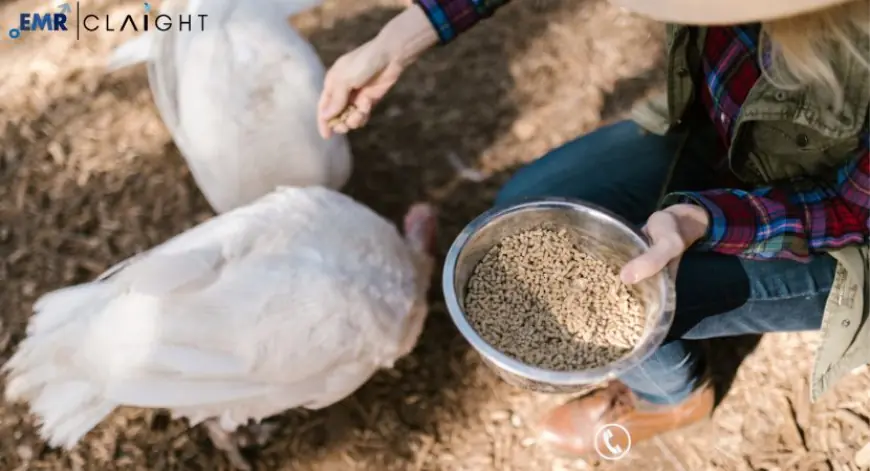Animal Feed Market Outlook (2025-2034): Growth, Trends, and Future Opportunities
Animal Feed Market

The global animal feed market size is witnessing steady growth, driven by the rising demand for meat, dairy, and poultry products. As livestock farming expands to meet the needs of a growing global population, the focus on nutritional, high-quality, and sustainable animal feed has intensified.
In 2024, the global animal feed market reached USD 559.37 billion. The market is projected to grow at a CAGR of 4.1% between 2025 and 2034, reaching USD 803.07 billion by 2034. This growth is fueled by technological advancements in feed production, increasing livestock farming, and stringent government regulations on feed quality.
This blog explores the market dynamics, key drivers, challenges, trends, and future opportunities shaping the animal feed industry worldwide.
Market Overview
Animal feed plays a vital role in livestock growth, health, and productivity. It includes nutritional formulations for various animals, such as poultry, cattle, swine, and aquaculture species.
Key feed types include:
- Compound Feed – A blend of grains, proteins, vitamins, and minerals for balanced nutrition.
- Forage and Roughage – Natural feeds like hay, silage, and pastures.
- Amino Acids and Additives – Supplements for enhanced growth and digestion.
- Medicated Feed – Feed infused with medicines to prevent livestock diseases.
With sustainability concerns and innovation in feed processing, the industry is shifting towards nutrient-rich, organic, and plant-based feed alternatives.
Key Market Drivers
Several factors are fueling the growth of the global animal feed market:
1. Growing Demand for Meat, Dairy, and Poultry Products
As the global population increases, so does the demand for protein-rich diets. Expanding meat and dairy consumption boosts livestock farming, increasing feed production needs.
2. Expansion of Livestock Farming and Aquaculture
The rise of commercial poultry, dairy, and fish farming has significantly driven feed demand. Countries with large-scale meat exports require nutrient-rich animal feed to enhance livestock productivity.
3. Technological Advancements in Feed Formulation
Feed manufacturers use AI, precision feeding, and enzyme technology to create cost-effective, high-protein, and disease-resistant animal feed. Innovations in fermentation-based feed and probiotics improve digestibility and health benefits.
4. Increasing Adoption of Organic and Non-GMO Feed
Consumers are shifting towards organic, antibiotic-free, and non-GMO meat products. This trend is driving the demand for organic feed formulations, encouraging sustainable animal husbandry.
5. Government Regulations on Feed Safety and Quality
Stringent regulations by bodies such as the FDA (U.S.), EFSA (Europe), and FSSAI (India) promote safe, contamination-free feed to prevent livestock diseases and enhance food safety.
6. Rising Investments in Sustainable and Alternative Feed Ingredients
The market is seeing increased use of algae, insect-based proteins, and plant-based feed ingredients, reducing dependence on traditional soybean and fishmeal feeds.
7. Growth of Pet Food and Companion Animal Nutrition
The pet food industry is expanding, with owners opting for high-quality, nutrient-dense pet feed, contributing to the broader animal feed market.
Market Challenges
Despite strong growth, the animal feed industry faces several challenges:
1. Fluctuations in Raw Material Prices
Key feed ingredients like corn, soybean meal, and wheat experience price volatility due to climate change, supply chain disruptions, and geopolitical tensions.
2. Environmental Concerns Related to Feed Production
Traditional feed production contributes to deforestation, water scarcity, and greenhouse gas emissions. The industry is under pressure to adopt sustainable feed sources.
3. Outbreaks of Livestock Diseases
Diseases such as African Swine Fever (ASF) and Avian Influenza affect livestock populations, reducing feed consumption and disrupting market stability.
4. Competition from Alternative Protein Sources
The rise of plant-based and lab-grown meat alternatives could reduce demand for traditional livestock farming and animal feed production.
5. Supply Chain Disruptions and Logistics Costs
The animal feed supply chain relies on international imports of key ingredients. Delays in transportation and increasing fuel costs affect profit margins.
Key Market Trends
Several emerging trends are shaping the global animal feed industry:
1. Increased Use of Precision Livestock Farming (PLF)
Farmers adopt IoT-enabled monitoring systems to track livestock health, diet, and feed efficiency, optimizing nutrient intake and minimizing feed waste.
2. Growth of Insect-Based and Alternative Protein Feeds
Companies explore insect meal, algae protein, and fermented yeast-based feeds as sustainable alternatives to traditional soy and fishmeal.
3. Adoption of AI-Powered Feed Formulation Software
AI-driven tools help customize feed formulations based on animal age, breed, and productivity levels, reducing waste and maximizing growth.
4. Expansion of Probiotic and Functional Feeds
Probiotic and prebiotic-infused feeds enhance gut health, immunity, and digestion, reducing the need for antibiotics in animal nutrition.
5. Rise in Direct-to-Farm Feed Delivery Services
E-commerce and logistics advancements allow farmers to order bulk feed directly from manufacturers, reducing middlemen costs and delivery delays.
6. Demand for Omega-3 and Fortified Animal Feed
Nutrient-rich feed with omega-3 fatty acids, vitamins, and antioxidants improves meat and dairy quality, meeting premium market demands.
Market Segmentation
The global animal feed market is segmented based on feed type, livestock, additives, and region.
1. By Feed Type
- Compound Feed – Balanced nutrition mix for livestock.
- Forage & Roughage – Grass, hay, and silage-based feed.
- Concentrates & Supplements – High-protein additives for growth.
2. By Livestock
- Poultry Feed – Broilers, layers, and turkeys.
- Cattle Feed – Dairy cows, beef cattle.
- Swine Feed – Piglets and finishing pigs.
- Aquafeed – Fish, shrimp, and crustaceans.
3. By Additives
- Amino Acids – Essential proteins for livestock growth.
- Enzymes & Probiotics – Improve digestion and immunity.
- Vitamins & Minerals – Enhance animal metabolism.
4. By Region
- North America – Advanced feed technology adoption.
- Europe – Strict regulations on organic and sustainable feed.
- Asia-Pacific – Fastest-growing region due to rising meat consumption.
- Latin America – Expanding cattle and poultry farming industry.
Future Outlook (2025-2034)
The animal feed industry will continue evolving with technological advancements, sustainability initiatives, and digital transformation. Key developments expected in the coming years include:
- Expansion of AI-driven feed optimization software.
- Growth in alternative protein feed sources (insects, algae, fermentation-based proteins).
- Increased government regulations on antibiotic-free feed production.
- Development of climate-smart feed solutions to reduce carbon footprint.
- Rise in smart farming and direct-to-farm feed delivery models.
With rising demand for high-quality livestock nutrition, advancements in feed technology, and sustainable production practices, the global animal feed market is set to reshape the future of animal agriculture over the next decade.
What's Your Reaction?
 Like
0
Like
0
 Dislike
0
Dislike
0
 Love
0
Love
0
 Funny
0
Funny
0
 Angry
0
Angry
0
 Sad
0
Sad
0
 Wow
0
Wow
0













































